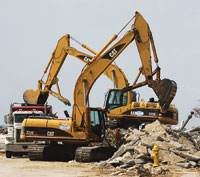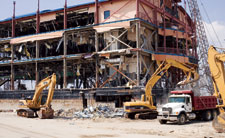 |
Anxious to eliminate huge piles of debris left behind by Katrinas winds and wall of water, the Army Corps of Engineers issued $2 billion to $4 billion in contracts on Sept. 16 for the removal of at least 77 million cu yd of material from Louisiana, Mississippi, and Alabama.
The contracts were awarded to Phillips & Jordan, Knoxville, Tenn.; Environmental Chemical Corp, Burlingame, Calif.; Ceres Environmental Services, Brooklyn Park, Minn.; and Ashbritt, Pompano Beach, Fla. Each company is currently contracted for up to $500 million in work with the Corps with the possibility of renewing for an additional $500 million. All four firms will work in Louisiana with Ashbritt serving as the prime in Mississippi and Phillips & Jordan in Alabama.
 |
| Unknown Quantity. Katrina tops Andrew. |
The size of the contract reflects the enormous volume of debris. "There is 4.5 to 5 times the debris from Andrew," says John Rickey, chief of public affairs for the Corps Mississippi Valley Division. Hurricane Andrew struck south Florida in 1992 and produced mountains of debris that took months to remove.
The current projects, funded by the Federal Emergency Management Agency, are for 55 million cu yd of debris in Louisiana, 20 million cu yd of debris in Mississippi and over 2 million cu yd in Alabama. The Corps expects to be responsible for all debris removal in Louisiana because the state has asked FEMA to handle the entire operation, says Rickey. The current work order for the Corps in Mississippi is 6 million cu yd of the 20 million cu yd. That number is likely to increase as the amount of debris is better understood, says Rickey.
|
The Mississippi Dept. of Environmental Quality is more certain that the FEMA numbers are off. "We are hearing that a lot of the preliminary estimates are low. We have estimated 35 million to 55 million cu yd of waste," says Mark Williams, administrator of DEQs solid waste branch. Rickey says the latitude within the Corps contracts reflects the uncertainty in estimating volume of debris and removal costs.
With so much unknown, the Corps is strictly monitoring the debris removal process to ensure that no money is wasted. Corps quality assurance officers are measuring the size of every subcontracted truck before it begins hauling. QA officers also are posted in towers at the dumpsites.
 |
| Casino Clean-Up. Harrison County, Miss., has chosen to remove its own debris. |
The current rules only allow the Corps to remove debris from roads and state rights of way in the 14 counties in Mississippi, 10 parishes in Louisiana and two counties in Alabama, where it has been asked to help. Some areas in Mississippi have chosen to remove their own debris, including Harrison County, which includes Biloxi and Gulfport.
Once the debris is removed it must be stored or recycled and the issue of contaminated waste still looms large. The Corps will incinerate anything that it can, including lumber and vegetation, according to MDEQ guidelines.
"Our preferred method is an incineration air curtain system," says Mike Logue, public affairs officer for the Corps Mississippi Valley Division. The rest of the waste will be recycled and condensed as much as possible, especially metal items. "The landfill is really our last resort for disposal," says Logue.
(Photos by Michael Goodman for ENR)



Post a comment to this article
Report Abusive Comment